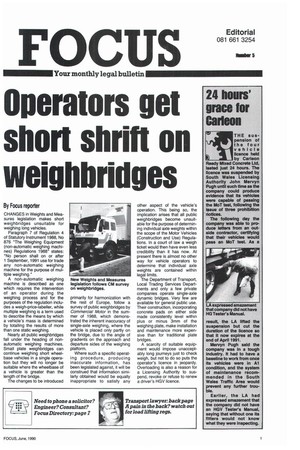Operators get short shrift o weighbridges
Page 3

If you've noticed an error in this article please click here to report it so we can fix it.
By Focus reporter
CHANGES in Weights and Measures legislation makes short weighbridges unsuitable for weighing long vehicles.
Paragraph 7 of Regulation 4 of Statutory Instrument 1988, No 876 "The Weighing Equipment (non-automatic weighing machines) Regulations 1988" states: "No person shall on or after 1 September, 1991 use for trade any non-automatic weighing machine for the purpose of multiple weighing."
A non-automatic weighing machine is described as one which requires the intervention of an operator during the weighing process and for the purposes of the regulation includes a weigh-price-labeller, while multiple weighing is a term used to describe the means by which a vehicle's mass is determined by totalling the results of more than one static weighing.
Nearly all public weighbridges fall under the heading of nonautomatic weighing machines. Small plate weighbridges can continue weighing short wheelbase vehicles in a single operation but they will no longer be suitable where the wheelbase of a vehicle is greater than the length of the bridge.
The changes to be introduced primarily for harmonization with the rest of Europe, follow a survey of public weighbridges by Commercial Motor in the summer of 1988, which demonstrated the inherent inaccuracy of single-axle weighing, where the vehicle is placed only partly on the bridge, due to the angle of gradients on the approach and departure sides of the weighing platform.
Where such a specific operating procedure, producing inaccurate information, has been legislated against, it will be construed that information similarly obtained would be equally inappropriate to satisfy any other aspect of the vehicle's operation. This being so, the implication arises that all public weighbridges become unsuitable for the purpose of determining individual axle weights within the scope of the Motor Vehicles (Construction and Use) Regulations. In a court of law a weigh ticket would then have even less credibility than it has now. At present there is almost no other way for vehicle operators to determine that individual axle weights are contained within legal limits.
The Department of Transport, Local Trading Services Departments and only a few private companies operate single-axle dynamic bridges. Very few are available for general public use. Their construction, incorporating concrete pads on either side made consistently level within plus or minus 3rnm of the weighing plate, make installation and maintenance more expensive than for traditional plate bridges.
A scarcity of suitable equipment would impose unacceptably long journeys just to check weigh, but not to do so puts the operator's licence in jeopardy. Overloading is also a reason for a Licensing Authority to suspend, revoke or refuse to renew a driver's HGV licence.




















































































































